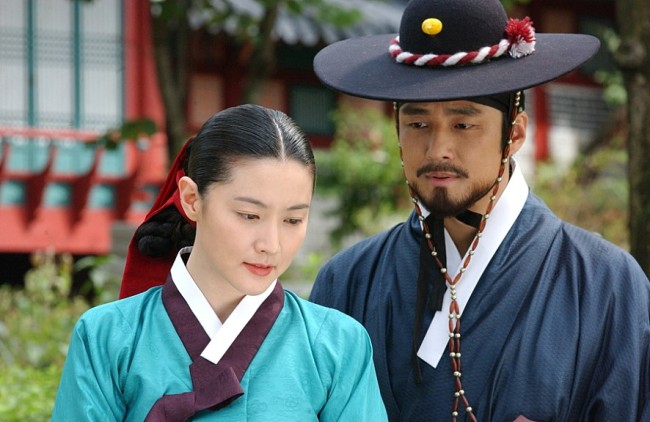A longtime fan of Korean dramas, Yu Yijie, a 25-year-old Chinese graduate student at Kookmin University, instantly fell for Korean entertainment watching “Full House,” starring Rain and Song Hye-kyo, which aired in 2004.
Since then, she has watched every popular Korean drama and gradually developed an interest in drama production.
“I thought I would come to Korea (to study) when I was watching ‘My Girl’ in 2005, which was a huge hit in China, starring Lee Jun-ki and Lee Da-hae,” said Yu, in a phone interview.
She came to Korea in 2012 and majored in public administration for her undergraduate degree. During summer and winter breaks she returned to China to intern at broadcasting companies. Then she decided to pursue a graduate degree in film and television at the university, turning her love of drama into the pursuit of a professional career in drama and film.
 |
A scene from “Jewel in the Palace” (2003) (MBC) |
“I wanted to learn advanced Korean drama and film production here,” said Yu.
Yu’s case is an illustration of the positive and productive influence that Korean dramas can have after more than a decade of popularity overseas.
Since the early 2000s, Korean dramas have grown enormously popular, spearheading the Korean culture wave, or hallyu, around the world.
The first drama to really get the Korean Wave going was “Winter Sonata” in 2002, which was exceptionally popular among middle-aged women in Japan.
The drama created an enormous fandom in Japan and catapulted the lead actor and actress -- Bae Yong-joon and Choi Ji-woo, who were called by honorific nicknames Yon-sama (Emperor Yon) and Jiwo Hime (Princess Jiwoo) -- into top stars in Asia.
 |
A scene from “Winter Sonata” (2002) (KBS) |
Another great success came a year later when the period drama “Jewel in the Palace” aired in 2003 on MBC. The drama was the first to attract popularity from beyond East Asia. It was sold to more than 90 countries, from China and Japan to places as far away as Kazakhstan and Hungary.
In Tajikistan, “Jewel in the Palace” reached a 70 percent viewership when it first aired in 2007, and had five reruns. In Kazakhstan, the popularity of “Jewel in the Palace” was followed by a series of successes of other Korean period dramas such as “Jumong” (2006), “Queen Seodeok” (2009), and “Dong Yi” (2010), according to “Global Hallyu 2015,” a report on trends in the Korean pop culture boom overseas.
Korean period dramas have had people of diverse nationalities take an interest in Korean traditional culture, costume, food and landscape, eventually attracting a growing number of tourists to Korea.
Korean dramas are very popular in East Asia and Southeast Asia, where Asians viewers easily relate to the Asian traditional values and features of an hierarchical society that are depicted in Korean dramas.
“Myanmar’s culture shares a great similarity with Korean culture as it values family, respect for elders and hospitality toward guests. The similar culture and customs, thoughts and languages between two countries made Burmese people receive Korean dramas easily,” said “Global Hallyu 2015.”
 |
A poster for “My Love from the Star” (2013) (SBS) |
Oh In-gyu, director general of the World Association for Hallyu Studies and a professor at Korea University, argues that there is another factor that allows Korean dramas to transcend borders and ethnicities.
“Korean dramas best represent feelings women of all nationalities can share. That is the feeling of melancholia,” said Oh.
“The state of melancholia can translate into the distinct state of Korean mind ‘han,’” he said.
Han may be a complicated psychological concept, but it refers to accumulated depression that hasn’t been unleashed. It was used to describe the psychological state of older Korean women who grew up and lived in the patriarchal and hierarchical society.
According to Oh, the Korean drama fever is driven by female viewers worldwide who share the sentiment.
“Whether it’s historical dramas, romantic melodramas, or dramas with violence, the primary viewers of Korean dramas are women,” said Oh.
In Korean dramas, the female protagonists overcome a series of obstacles before they find their true love and achieve career success. In “Jewel in the Palace,” the protagonist Jang-geum, who comes from a disgraced family, enters the palace to become an assistant for kings and queens. She works her way up from being an assistant cook to a court doctor.
“Women feel a sense of catharsis watching the female character grow.”
 |
A scene from “The Heirs” (2013) (SBS) |
From 2010 to 2013, Oh conducted an interesting test in Israel, France and the United Kingdom to check different reactions of male and female viewers watching Korean dramas. Oh screened five different dramas and observed the viewers’ responses.
“Men showed little interest in drama stories, while women quickly became attached to the characters.”
Another factor that attracted global female audiences to Korean dramas is the ideal male figures portrayed in Korean dramas, Oh explained.
“Korean men are sensitive, kind and fashionable in dramas. They are the ideal type for most of women,” said Oh.
The most popular Korean drama airing in Argentina is “Stairway to Heaven,” which came out in 2003 in Korea. A news article published on March 9, in the Argentinian newspaper Clarin picked the drama as one of the most-watched television programs, with a 10 percent viewership rating, and wrote about its popularity among Argentinian households. The drama features a male protagonist played by Kwon Sang-woo, who is devoted to his ailing childhood sweetheart and protects her until her death with the promise of everlasting love.
By Lee Woo-young(
wylee@heraldcorp.com)



